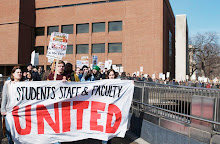We are told that the University needs to be more aggressive in pursuing new sources of revenue. With new sources of revenue, we can sustain excellence in the face of declining state support. Some have stated that faculty need to go out and get lots of big grants. But these grants do not cover their costs, as discussed on this blog previously(see "Big grants...not the solution to our budget woes"). But what about patents? Can the U harness the intellectual power of its faculty to produce things that the market values, claim ownership of them via a patent, and then use the revenue from licensing fees and royalties to subsidize our academic mission?
The U is currently proposing changes to the Regents Policy on Commercialization of Intellectual Property Rights. Jay Schrankler, Director of the Office for Technology Commercialization (OTC), presented the proposed changes to this policy to the Senate Research Committee on April 19. The revised policy is scheduled for action at the June 10 meeting of the Board of Regents.
Some select tidbits from the minutes of the Senate Research Committee meeting (commentary will follow the excerpts from the minutes):
***
...the University derives significant benefit from a robust technology-commercialization operation, federal policy (the 1980 Bayh-Dole Act) requires universities to commercialize technology developed with federal support (NOTE: THIS IS FALSE. BAYH-DOLE DOES NOT REQUIRE COMMERCIALIZATION, IT MERELY MAKES IT POSSIBLE.), technology commercialization is a costly function, they are seeking ways to normalize funding for technology commercialization comparable to peer institutions, and need to identify changes to current policy that would be necessary to achieve this normalization. The reason it is an expensive process is because the initial patent cost is about $3,000-$4,000, it costs on average between $25,000-$30,000 to obtain a US patent (it can be more), and can cost a great deal more (into the hundreds of thousands/millions) in future years to maintain US & international patents on a particular technology. One problem is that the licensing revenue from a number of patents does not end up covering their costs. Over half of the OTC budget is to pay for filings to protect intellectual property. Moreover, there is increasing pressure on universities to serve as vehicles of economic development in order to create jobs, and Minnesota is among a number of institutions responding to a federal Request for Information on how universities can do so. He also mentioned that many, if not all, federal grants require grantees to cover commercialization in their proposals.
Mr. Schrankler turned to the current funding model for OTC. It is exclusively self-funded through royalty revenue and receives no central administrative (O&M) funds. The major royalty revenue stream (from Glaxo for the HIV drug Ziagen, which makes up 90% of total revenue) is in decline as patent coverage sunsets. OTC assumes all the risks and the costs associated with intellectual-property protection and licensing—it must entirely cover costs for "winners" as well as "losers." The current University funding model is an exception when compared with its peers.
The model needs to change, Mr. Schrankler told the Committee, because a key source of OTC funding, the Ziagen royalties, are going to disappear; for the Office of the Vice President for Research they are predicted to amount to about $13 million in the current fiscal year, then $12 million, $10 million, $9 million, and zero in subsequent years. (The University has received $421 million in Ziagen royalties during the period 2000-2009 which were then distributed according to the current policy.)
Under the current Regents' policy, Mr. Schrankler said, the University loses money on some inventions. He provided two real examples, where the income was distributed according to the formula (1/3 to the inventor, 1/3 to the college/department, and 1/3 to the Office of the Vice President for Research). What happened, however, was that there was a net loss to the Office of the Vice President for Research because of the costs absorbed, even with the 1/3 of the funds the office received. They believe that a portion of the overall costs associated with that technology (which includes but is not limited to just patent costs) should come off the top, before income is distributed.
What they are proposing is the implementation of a technology-transfer service fee that is comparable to that used by peer institutions. They do NOT proposed to reduce or cap distributions (that does not seem productive if the idea is to encourage entrepreneurialism), they do not have an endowment to draw on, and they do not believe it appropriate to ask for central-administrative funds, especially at this time of financial constraints. So they recommend retaining the 1/3-1/3-1/3 split after payment of a 15% service fee and patent costs; they also recommend aggressive OTC financial goals, as measured by disclosures, patents, and so on. They are also recommending allowing University investment in commercially-focused efforts in order to earn a financial return. (Some of the biggest donations to the University have come in bad economic times, and they believe it is time to approach donors to support a start-up fund the University can use to invest in new companies in order to earn a return.) The change, Mr. Schrankler said, would allow the University to fund an appropriately-robust technology-transfer activity. It represents a reasonable balance between risk and reward, it reflects peer practices, and it will provide a level of funding that will allow OTC to do its work.
***
On a positive note, OTC is self-financing and under the current proposal will still be so. But one wonders if this will continue to be possible once the revenues from Ziagen dry up. Playing the patent game is much like playing the lottery. But more fundamentally, madradprof questions whether the public-private partnerships that fund much of this research and the patenting of inventions by a public institution (often with public funds) can be done without comprising the integrity of both our academic mission and our role as an institution that serves the public. The ship has already sailed on this issue to some extent, but we should think carefully before moving further down this path.
In a recent article in the Boston Review, Marcia Angell, the former editor of the New England Journal of Medicine, delivers a devastating critique of of how corporate dollars corrupt research:
http://bostonreview.net/BR35.3/angell.php
She notes that the academy's dependence on industry funding has skewed research agendas toward things that generate profits: "...new antibiotics for treating infections by resistant organisms are an urgent medical need, but are not economically attractive to industry because they are not likely to generate much return on investment." Moreover, many academic researchers have essentially become hired hands for the commercialization of corporate products. "Industry-supported research is far more likely to be favorable to the sponsor's products than is NIH-supported research." Not to mention the ethics of public universities living off royalties for drugs that pharmaceutical companies sell at inflated prices. I wonder how many poor people afflicted with HIV can afford to pay for Ziagen?
It is worth quoting in full her recommendations for reform:
First, members of medical school faculties who conduct clinical trials should not accept any payments from drug companies except research support, and that support should have no strings attached. In particular, drug companies should have no control over the design, interpretation, and publication of research results. Medical schools and teaching hospitals should rigorously enforce this rule and should not themselves enter into deals with companies whose products are being studied by members of their faculty.
Second, doctors should not accept gifts from drug companies, even small ones, and they should pay for their own meetings and continuing education. Other professions pay their own way, and there is no reason for the medical profession to be different in this regard.
Finally, academic medical centers that patent discoveries should put them in the public domain or license them inexpensively and non-exclusively, as Stanford does with its patent on recombinant DNA technology based on the work of Stanley Cohen and Herbert Boyer. Bayh-Dole is now more a matter of seeking windfalls than of transferring technology. Some have argued that it actually impedes technology transfer by enabling the licensing of early discoveries, which encumbers downstream research. Though the legislation stipulates that drugs licensed from academic institutions be made “available on reasonable terms” to the public, that provision has been ignored by both industry and academia. I believe medical research was every bit as productive before Bayh-Dole as it is now, despite the lack of patents. I’m reminded of Jonas Salk’s response when asked whether he had patented the polio vaccine. He seemed amazed at the very notion. The vaccine, he explained, belonged to everybody. “Could you patent the sun?” he asked.
I’m aware that my proposals might seem radical. That is because we are now so drenched in market ideology that any resistance is considered quixotic. But academic medical centers are not supposed to be businesses. They now enjoy great public support, and they jeopardize that support by continuing along the current path.
And to those academic researchers who think the current path is just fine, I have this to say: no, it is not necessary to accept personal payments from drug companies to collaborate on research. There was plenty of innovative research before 1980—at least as much as there is now—when academic researchers began to expect rewards from industry. And no, you are not entitled to anything you want just because you’re very smart. Conflicts of interest in academic medicine have serious consequences, and it is time to stop making excuses for them.
Subscribe to:
Post Comments (Atom)


No comments:
Post a Comment